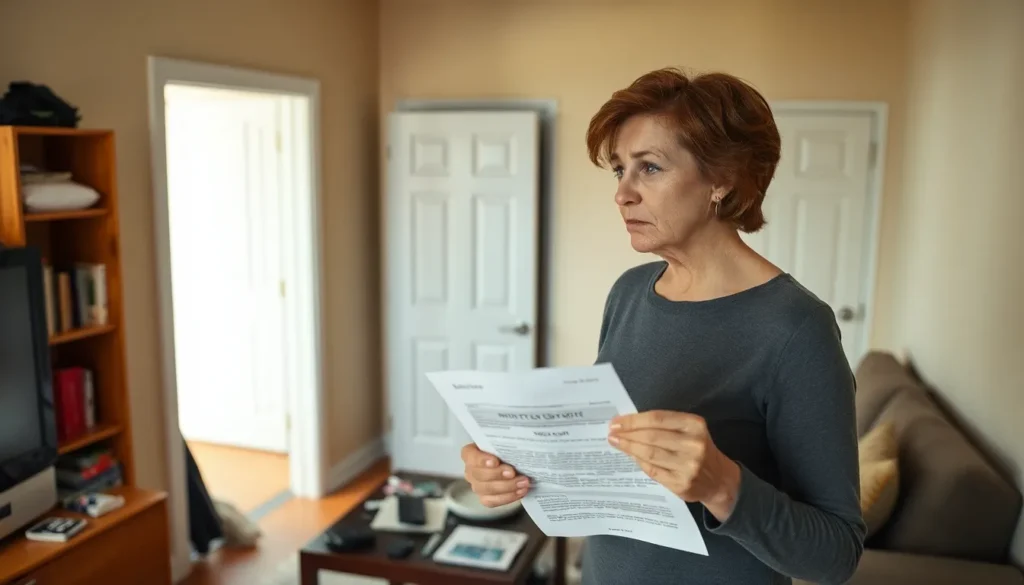Table of Contents
ToggleNavigating the world of home buying can feel like trying to solve a Rubik’s Cube blindfolded. Enter the mortgage—a term that sounds more like a spell from a wizarding world than a financial tool. But don’t worry; it’s not as daunting as it seems. Simply put, a mortgage is a loan specifically for purchasing a home, allowing folks to buy that cozy nest without needing a treasure chest full of gold.
What Is a Mortgage?
A mortgage is a specific type of loan obtained to purchase real estate. Lenders provide these loans based on the property’s value, allowing buyers to finance their home purchases. Homebuyers repay the loan amount over an agreed term, usually spanning 15 to 30 years.
Securing a mortgage often requires a down payment, which typically ranges from 3% to 20% of the home’s purchase price. Borrowers pay interest on the loan, and the interest rate can be fixed or adjustable. Fixed-rate mortgages maintain the same interest rate throughout the loan term, while adjustable-rate mortgages may fluctuate based on market conditions.
Monthly mortgage payments include principal and interest, along with homeowners insurance and property taxes. Escrow accounts often hold these costs, ensuring timely payments on behalf of the homeowner. Understanding these components can clarify what buyers pay monthly.
Mortgages can come in various types, including conventional, FHA, and VA loans. Conventional mortgages typically follow the guidelines set by Fannie Mae and Freddie Mac. FHA loans are backed by the Federal Housing Administration and cater to first-time buyers, while VA loans assist eligible veterans and active military members.
The mortgage process involves several steps, including pre-approval, application, and closing. Pre-approval provides a clearer picture of what buyers can afford, while the application gathers detailed financial information. Closing finalizes the mortgage, transferring ownership of the property to the new homeowner.
Knowledge of these elements assists potential buyers in navigating the complexities of purchasing a home while leveraging a mortgage effectively.
Types of Mortgages
Various types of mortgages cater to different financial situations and preferences. Understanding these variations helps buyers select the best options for their needs.
Fixed-Rate Mortgages
Fixed-rate mortgages offer a stable interest rate throughout the loan’s term. Borrowers benefit from predictable monthly payments, making budgeting easier. Terms generally range from 15 to 30 years, allowing flexibility in long-term planning. It’s common for the interest rates on these loans to remain unchanged, safeguarding borrowers from market fluctuations. Lenders base approval on credit scores, income, and debt-to-income ratios. Popularity stems from the consistency of payments, making them a preferred choice for many first-time homebuyers.
Adjustable-Rate Mortgages
Adjustable-rate mortgages (ARMs) start with a lower interest rate that may change over time. Initial fixed-rate periods typically last 5, 7, or 10 years. After this phase, rates fluctuate based on market indexes, which can increase or decrease payments significantly. Borrowers often enjoy lower initial payments, potentially making homeownership more accessible. Equity can build quickly during the fixed period. Understanding the risks associated with rate adjustments is essential, as significant increases could affect long-term affordability.
The Mortgage Process
The mortgage process consists of several key steps that help prospective homebuyers secure financing for their new homes.
Pre-Approval
Pre-approval is an essential first step. It involves lenders evaluating a borrower’s creditworthiness, income, and financial history. By doing this, lenders determine a maximum loan amount for which a buyer qualifies. Homebuyers should gather documents like recent pay stubs, bank statements, and tax returns to streamline this process. Receiving a pre-approval letter enhances a buyer’s negotiating power when making an offer on a home since it demonstrates serious intent to sellers. Most lenders provide pre-approval within a few days, making it a crucial part of the homebuying journey.
Closing the Loan
Closing the loan marks the final stage of the mortgage process. During this step, all parties involved—including buyers, sellers, and lenders—come together to finalize the transaction. The lender prepares a closing disclosure outlining the loan terms, monthly payments, and closing costs, which the borrower must review in detail. It’s important to address any questions at this stage to avoid last-minute issues. Borrowers then sign various documents, and the loan is funded. This entire process typically takes 30 to 45 days from initial application to closing, culminating in the transfer of property ownership.
Key Terms to Understand
Understanding mortgage terminology simplifies the home buying journey. Key terms include principal, interest, escrow, and insurance.
Principal and Interest
Principal refers to the original amount borrowed. When homebuyers make monthly mortgage payments, a portion goes toward reducing the principal. Interest represents the cost of borrowing money, calculated as a percentage of the remaining principal. Fixed-rate mortgages maintain consistent interest rates throughout the loan term. Conversely, adjustable-rate mortgages may start with lower interest rates that can fluctuate, impacting monthly payments. Familiarity with these terms helps borrowers anticipate financial obligations and make informed decisions.
Escrow and Insurance
Escrow serves as a neutral account holding funds for specific purposes, like property taxes and homeowners insurance. Lenders often require escrow accounts to ensure these payments are made timely. Homeowners insurance protects against damage to the property, covering repairs and liability. It’s critical for borrowers to understand that these expenses are part of their total mortgage payments. Missing escrow payments can lead to financial strain or policy lapses. Knowing how escrow and insurance function supports effective mortgage management.
Conclusion
Understanding mortgages is essential for anyone looking to buy a home. This financial tool makes homeownership accessible by allowing individuals to spread the cost over many years. By knowing the different types of mortgages and the associated terms, buyers can make informed decisions that align with their financial goals.
Navigating the mortgage process may seem overwhelming at first. However, with the right knowledge and preparation, prospective homeowners can confidently approach lenders and secure favorable terms. Ultimately, a well-chosen mortgage can pave the way to achieving the dream of homeownership while ensuring financial stability for years to come.








